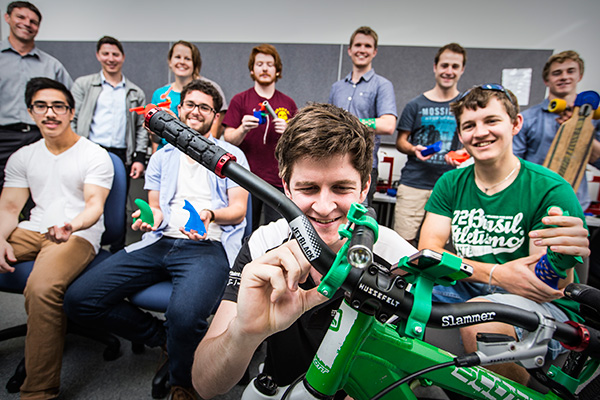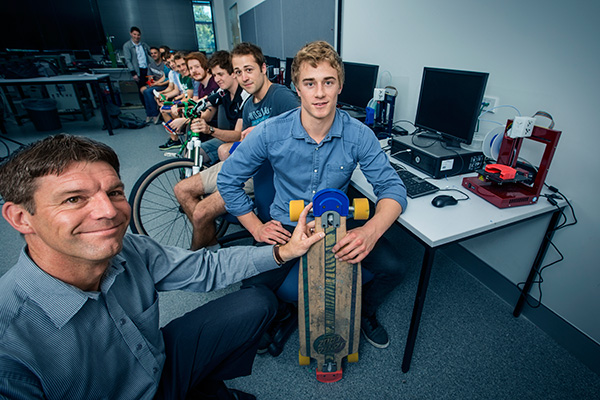October 23, 2014
Face of engineering takes on a new look
New 3D printing subject places undergraduate students at forefront of engineering paradigm shift.

Engineering student Tim Davis shows off his 3D printed bike light and phone holders.
An inaugural subject that has clearly demonstrated the changing face of traditional engineering could significantly increase in size next year to cope with the expected influx of undergraduate students.
Unconstrained by traditional engineering methods such as stripping away materials using lathes and milling machines, 38 students undertaking the new Introduction to Additive Manufacturing subject have been able to build what they imagine through 3D printing.
“It’s all about rapid prototyping and customisation these days,” according to Subject Co-ordinator Dr Steven Harvey a UOW engineering graduate who now works mainly at Wollongong Hospital. With an interest in using 3D printing to fabricate anatomical structures for surgical and medical use, Dr Harvey is an Honorary Senior Fellow with the School of Mechanical, Materials and Mechatronic Engineering.
Dr Harvey said 3D printing represented a paradigm shift in approaches to manufacturing.
“While traditional manufacturing involves processes such as machining, casting and forging where material is removed to reveal the final design, 3D printing builds a computer-generated design layer-by-layer,” he said.
Dr Harvey said there were very few taught university subjects in Australia such as the sessional Introduction to Additive Manufacturing offered at UOW this year. Subject Tutor and Lab Demonstrator for the course has been Research Fellow, Dr Rahim Mutlu, who is also from the School of Mechanical, Materials and Mechatronics. The pair expects there will be a need to double the number of 3D printers that they now have in order to cope with student numbers in 2015.
Head of the School, Professor Gursel Alici, who is also the leader of the Soft Robotics for Prosthetic Devices research theme at the UOW-headquartered ARC Centre of Excellence for Electromaterials Science said the school has been striving to equip its students with cutting-edge knowledge and skills in order to give them an edge in taking the full advantage of this new technology in their professional life.

Additive Manufacturing Subject Coordinator Steven Harvey with Andrew McGill and his 3D skate board protectors, along with other students with their 3D printed presentations.
The school’s next plan is to link the additive manufacturing (i.e.3D printing) with biomedical engineering through offering new specialised subjects based on the synergy between these two fields that will have a real impact on novel medical technologies.
The new subject took students through a complete design and build cycle where they were asked, in groups, to identify a product that was suitable for manufacture by 3D printing, either an existing device that requires redesign, or a new creation altogether.
The design process included generating design concepts and eventually a 3D computer model that was converted to a format suitable for 3D printing. After the design was printed it was tested to assess its technical performance.
Students also had to study the fundamental knowledge of the history, principles and processes of 3D printing.
Dr Harvey said of the eight group projects presented for final assessment, all could be commercialised in his opinion as they were customisable and hence very adaptable.
Student groups were all given the same amount of plastic filament (ABS plastic) and identical 3D printers to work with so no one group had any unfair advantage.
Group one developed customised toe/kick guards for a skateboard; group two developed a customised oar grip attachment to aid people with disabilities; group three developed a customisable/modular bicycle mount which could accommodate items such as iphones, torches or cameras; group four developed a lightweight customisable plastic lower arm caste with ventilation holes; group five developed a customisable thrust measuring rig for a quadcopter (drone); group six developed a series of customisable surfboard fins; group seven developed a customisable ‘pig’ (pipe cleaning device) for the oil and gas industry; and group eight developed a range of customisable eyewear.
Dr Harvey said: “This is really a revolution in engineering which has opened up a wealth of opportunities in the production of fully customisable, non-uniform objects that were previously impossible to manufacture conventionally.”
“We are no longer restricted by the constraints imposed by traditional engineering tools. We are teaching ‘What You See Is What You Build’. If you can visualise it on screen in 3D then you can most likely build it.”
“What is slowly emerging from industry feedback is that a different type of engineering graduate, one well-versed in the creative as well as the technical areas of design is what is now required,” Dr Harvey said.
“We are now in the era of ‘mass customisation’, and this has particular application in the medical device, surgical and aerospace fields,” he said.
But this property is also one of its weaknesses. Three-dimensional printing cannot, at the moment anyway, hope to compete with mass production manufacturing techniques such as injection moulding or investment casting.
It is simply too slow and still requires a high degree of human intervention to remove support structures in post-processing. Engineering graduates will still need, for the foreseeable future, a very strong grounding in traditional manufacturing fundamentals.”